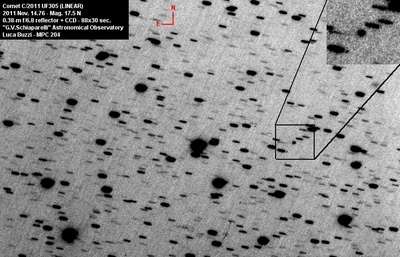Comet C/2011 UF305 (LINEAR)
Its very unusual preliminary orbital elements (a=16.94, e=0.86, i=95.45) yield a Tj around 0.13, making it one of the primary T3 project targets.
After the MPEC was released, Hidetaka Sato wrote to our internal mailing-list about its possible cometary feature, describing the object having a FWHM larger than stars nearby (4.9″ vs 3.5″).
After his alert, I managed to observe it on Nov. 12 and 14: in the first night seeing was not good, but two days after conditions were very good, and I was able to confirm its cometary feature, with a coma 7″x5″ and a FWHM 25% larger than stars nearby (2.9″ vs 2.4″).
After a private e-mail exchange with Jim Scotti from Spacewatch, I knew that he also observed its cometary aspect on Nov. 2 and 3 with the 1.8-m f/2.7 reflector + CCD, with a 10″ coma and a tail 0.14′ in PA 99°.
So we all waited for an official announce, which arrived a bit later on Dec. 29 with CBET 2960 (subscription required) with observations and orbital elements on MPEC 2011-Y51.
No clear tail can be seen, only the eastern edge of the coma seems less defined than the western edge, but nothing more. In good seeing conditions the “FWHM method” is the most reliable instrument we have to understand if we are in presence of a coma or not.
Now the object is slowly emerging from the solar conjunction, and it will be soon visible in the morning skies.
The comet will pass perihelion on 2012 Jul. 22.1 at a solar distance of around 2.14 AU, reaching an apparent magnitude between 14 and 15 and located in the northern circumpolar sky.
